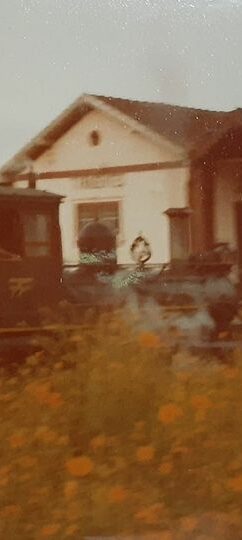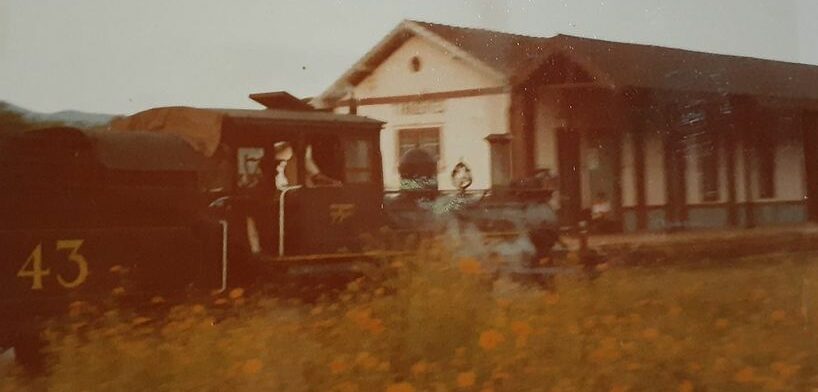



Click on the map and explore the content!
Em Tiradentes havia extração de caulim, uma matéria–prima utilizada na fabricação de louças, tintas, cimento, dentre outros. Ele era extraído na Serra de São José e levado até a Estação Ferroviária, onde era preparado e depositado para transporte pelo trem. Em frente à Estação, havia um depósito de caulim, para a qual também foi feito um desvio ferroviário para facilitar o carregamento.
Em frente à estação, bem próximo à linha, existiu uma casinha simples onde vivia um senhor chamado Henrique, provavelmente a única ocupação residencial no entorno imediato da estação.
Foi uma fábrica de tijolos cerâmicos localizada do lado direito da linha férrea, próximo à Estação Tiradentes. Esteve em atividade durante as primeiras décadas do século 20.
This factory produced ceramic products and was located near Tiradentes Station. Its tall brick chimneys were prominent features of the landscape. Ceramics were the primary product manufactured in Tiradentes and distributed by the train. A rail siding was attached to the railway line, leading the tracks into the factory premises, thereby facilitating the loading of products onto the wagons.
“Back then, the train was the main mode of transportation. Cars and trucks were scarce. So, everything was transported by train. The ceramics factory had its own siding: they would bring the locomotive in, load the materials onto the wagons, and then send them off. Usually, the train would arrive in the morning, leave the wagons at the factory for loading, and depart. In the afternoon, it would return to pick up the loaded wagons and continue its journey. There was also a siding for kaolin, located nearby; everything was conveniently close to the station.”
Bruno Nascimento Campos, researcher and resident of São João del-Rei.
Entre as Estações de Tiradentes e de Prados localizava-se a caixa-d’água, onde a locomotiva a vapor era abastecida. Ao lado da caixa-d’água havia uma plataforma para embarque e desembarque de produtos e passageiros, e uma pequena guarita onde trabalhavam funcionários da ferrovia. O vilarejo rural que cresceu nos arredores dessa parada ficou conhecido como comunidade da Caixa D’Água da Boa Esperança.
Desde sua inauguração em 1881, a Estação Tiradentes e a linha férrea, assim como as atividades relacionadas ao trem de ferro, passaram por uma série de mudanças. Consequentemente, os arredores da estação, também tiveram sua forma e sua dinâmica alteradas ao longo dos anos.
A praça próxima à Estação passou por algumas transformações ao longo do tempo. Até meados do século 20, o local era uma cavidade tomada pelo mato. Nas décadas seguintes, a praça foi construída e os jardins foram plantados. Segundo relatos de moradores, o coreto foi acrescido ao conjunto após alguns anos.
A Companhia Industrial Tiradentes, conhecida como CITI, foi uma fábrica de cal. Um dos fornos utilizados no tratamento da cal, remanescente da época, ainda existe e pode ser visto perto da linha férrea.
Naqueles arredores e ao longo da linha férrea, pequenas flores de cosmos, de tom amarelo-alaranjado, cresciam aos montes, colorindo a paisagem.
These were clusters of houses located near the railway line, providing accommodation for workers involved in maintaining the line. Constructed in the eclectic architectural style, they used materials similar to those found in railway stations, such as French roof tiles and pine wood. Typically, each cluster had three or four houses, accommodating workers and their families. Houses along the Tiradentes and Águas Santas branches were eventually demolished, leaving only the foundation of some.
O pontilhão foi construído entre 1879 e 1881, possibilitando a travessia do trem de ferro sobre o rio Elvas. Uma base de madeira colocada no centro dos trilhos permitia que ele fosse atravessado a pé. Por isso, o pontilhão não era só lugar de passagem, mas também de lazer dos moradores de Tiradentes, que faziam passeios pelo pontilhão e proximidades, principalmente aos domingos. O pontilhão do rio Elvas ainda está em uso e é um dos poucos preservados de seu estilo.
This cave is situated within a rocky complex, currently an area used for limestone extraction, which since the early 20th century has served as a source of raw material for cement production. During that time, this product was transported by railway, primarily destined for Barroso.
For many years, Casa de Pedra was also a gathering place and recreational area for the local population. It was quite common for people from both cities to visit the cave on Sundays, where they would gather with friends and family for picnics, relaxation, fishing, and cycling.
Kaolin extraction took place in Tiradentes, providing raw material used in pottery, paints, cement, and other products. It was extracted in Serra de São José and transported to the Railway Station, where it was processed and deposited for transport by train. There was a kaolin depot in front of the station, with a rail siding built to facilitate loading.
In front of the station, right by the tracks, there was a small, simple house where a man named Henrique lived. It was likely the only residential property in the immediate area surrounding the station.
“Cerâmica do Joaquim Barbosa” was a ceramics brick factory on the right side of the railway line, near Tiradentes Station. It operated during the early 20th century.
The streets were unpaved, lacking asphalt or stone, with no cement sidewalks. The square in front of the station was neglected, overrun by weeds. Many remember it flooding during floods from Rio das Mortes.
Companhia Industrial Tiradentes (Tiradentes Industrial Company, CITI) was a lime factory. One of the kilns used for lime treatment, dating back to that era, still exists and can be seen near the railway line.
This cave is situated within a rocky complex, currently an area used for limestone extraction, which since the early 20th century has served as a source of raw material for cement production. During that time, this product was transported by railway, primarily destined for Barroso.
For many years, Casa de Pedra was also a gathering place and recreational area for the local population. It was quite common for people from both cities to visit the cave on Sundays, where they would gather with friends and family for picnics, relaxation, fishing, and cycling.
The bridge was constructed between 1879 and 1881, allowing the railway to span the Elvas river. A wooden platform placed in the center of the tracks allowed pedestrian crossing. Thus, the viaduct served not only as a passageway but also as a leisure spot for Tiradentes residents, who would often stroll across it and its surroundings, especially on Sundays. The Rio Elvas Bridge remains in use today and is one of the few preserved examples of its style.
These were clusters of houses located near the railway line, providing accommodation for workers involved in maintaining the line. Constructed in the eclectic architectural style, they used materials similar to those found in railway stations, such as French roof tiles and pine wood. Typically, each cluster had three or four houses, accommodating workers and their families. Houses along the Tiradentes and Águas Santas branches were eventually demolished, leaving only the foundation of some.
“I recall the homes along the railway, leading towards the Elvas bridge. That area, now known as Várzea de Baixo, was nonexistent back then. Instead, there was a ravine with only a few houses where the railroad workers responsible for maintaining the tracks resided. I remember this vividly because my mother used to visit there; our family had close friendships with the residents.”
Gilberto Luiz Caldas, resident of São João del-Rei and son of a railroad worker.
In those surroundings and along the railway line, clusters of small cosmos flowers with yellow-orange hue bloomed abundantly, painting the landscape with vibrant colors.
Since its inauguration in 1881, the Tiradentes Station and the railway, as well as activities related to the train, have undergone a series of changes. Consequently, the surroundings of the station have also had their form and dynamics altered over the years.
This factory produced ceramic products and was located near Tiradentes Station. Its tall brick chimneys were prominent features of the landscape. Ceramics were the primary product manufactured in Tiradentes and distributed by the train. A rail siding was attached to the railway line, leading the tracks into the factory premises, thereby facilitating the loading of products onto the wagons.
“Back then, the train was the main mode of transportation. Cars and trucks were scarce. So, everything was transported by train. The ceramics factory had its own siding: they would bring the locomotive in, load the materials onto the wagons, and then send them off. Usually, the train would arrive in the morning, leave the wagons at the factory for loading, and depart. In the afternoon, it would return to pick up the loaded wagons and continue its journey. There was also a siding for kaolin, located nearby; everything was conveniently close to the station.”
Bruno Nascimento Campos, researcher and resident of São João del-Rei.
Entre as Estações de Tiradentes e de Prados localizava-se a caixa-d’água, onde a locomotiva a vapor era abastecida. Ao lado da caixa-d’água havia uma plataforma para embarque e desembarque de produtos e passageiros, e uma pequena guarita onde trabalhavam funcionários da ferrovia. O vilarejo rural que cresceu nos arredores dessa parada ficou conhecido como comunidade da Caixa D’Água da Boa Esperança.